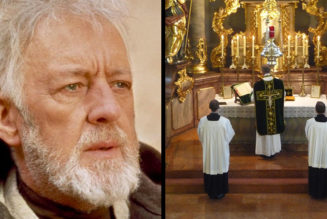The pattern of behavior shown by Jesuit leadership in the management of at least one current high-profile scandal has centuries of institutional practice behind it. That’s according to one prominent historian, Ulrich Lehner of the University of Notre Dame, who has just published a German-language study of the Jesuits’ historical handling of abuse in their ranks.
In a broad-ranging conversation with Crux in March, Lehner explained that in fact, what may appear to be a relatively recent development in the life of the Church is really the current chapter in a crisis, the roots of which go down through the last several centuries and almost certainly even further.
“This isn’t a crisis that began in the 1960s,” Lehner told Crux, “far from it.”
Lehner is the William K. Warren Professor of History at the University of Notre Dame in South Bend, In. An expert in the history of Christianity from 1500 to the present, Lehner has authored or co-authored more than a dozen books ranging both academic and popular, including a 2022 volume on The Inner Life of Catholic Reform: From the Council of Trent to the Enlightenment.
Lehner’s latest is Staged Chastity: Sexual Offenses in the Society of Jesus in the Seventeenth and Eighteenth Centuries (314pp Berlin: De Gruyter, 2023), published in German and available for download as Inszenierte Keuschheit: Sexualdelikte in der Gesellschaft Jesu im 17. und 18. Jahrhundert.
In the book, Lehner uncovers a mixture of power, money, ambition and influence – much of it brought to bear on “problem figures” in the Society of Jesus for reasons that are in themselves blameless if not praiseworthy – that is readily recognizable in the behavior of churchmen today.
Some of the stories are gruesome beyond telling – though Lehner slogged through the primary sources that tell them – and all the more appalling for how familiar they are.
One in particular, the 17th-century story of Jesuit Theoderich Beck bears startling similarity to accounts much less far removed from us in time. Confessor to Friedrich Cardinal von Hessen, Beck also had numerous young grammar school (roughly modern-day high school-aged) pupils in his charge, many of whom he forced to perform sex acts.
“They knew that this man had raped, continuously, high school students from the Jesuit school – invited them to the castle and raped them for weeks as ‘summer vacation’,” Lehner said. “Think about the McCarrick beach house,” he said. “The [Jesuit] General wanted to lock this man up, but he was at the side of a very powerful and influential protector, so they didn’t really know what to do.”
The Jesuits tried to convince von Hessen to release Beck, but “nothing worked, so, in the end, for almost thirty-five years, they tried to get this Jesuit to come back,” and to separate from his cardinal protector. “There may have been a relationship there, too,” Lehner noted. “That never happened,” Lehner said, “so the cardinal takes his man to Rome, who stays as his confessor until he dies.”
When a Bavarian historian, Karl Ritter von Lang, uncovered records of the abuse and began to tell the tale in the early 19th century, the Jesuits attacked Lang and minimized – successfully for a while – their long-dead confrère’s criminal conduct.
Staged Chastity covers a great deal of territory over two centuries – the 17th and 18th – in which the Jesuit order had already established itself as a major force in the increasingly global Church and in European politics.
The book mainly explores primary source material from areas in central Europe – archive records and accounts of both abusive behavior and institutional methods of dealing with it – but his research covers a broad swathe of continental territory, including Spain and Portugal (and their overseas imperial territories in the New World, mostly through secondary sources and for comparison), all connected somehow or other to the Jesuits’ and the Church’s central governing apparatus in Rome.
“The Jesuit archives were wonderful,” Lehner told Crux. “When I applied to the [German] province for some funding to put the book in open access online – I first hesitated – they were extremely kind and generous.”
The Jesuits offered practical assistance as well. When Lehner needed something from the Roman archives, he received what he needed almost immediately. “I emailed them in the morning,” he said, “and I had the scan sometime in the afternoon.”
“Even in previous centuries, there were sexual crimes committed by clergy,” Lehner said.
That isn’t news in itself, but it is painfully revealing and necessary, he explained, to recognize the toxic admixture of concern to avoid scandal – to preserve not only the good name of bad clerics but the general reputation of the Society of Jesus – and to protect the institution of the Church more broadly.
“The Jesuits had the reputation of being the most chaste order,” Lehner said, noting a misconception popular both then and now, according to which joining the Jesuits could almost magically cure a person of disordered sexual urges.
“It would be interesting to know on what scale that was,” Lehner added. “It is a parallel to cases we have documented in the 21st century,” Lehner also said, “where we have people – we would call them ‘immature personalities’ – who think that joining the priesthood or a religious order – that the reception of Holy Orders – makes them automatically able to deal with their sexual desires.”
“The Jesuits themselves would have said that such was not an appropriate understanding,” of their spirituality, “and they had really high standards of how they screened their candidates,” Lehner said. “At every step,” from the novitiate through the various formative stages in Jesuit life, to ordination and beyond, “you’re constantly under a quality control.”
“That was probably better than any other religious order,” Lehner said, “and certainly better than in the secular clergy.”
Part of the problem, in other words, was that the Jesuits really were trained well and frequently were of a very high intellectual and moral caliber. “[The Jesuits] probably did have a much better quality of screening of candidates,” Lehner said, “and a very long process of formation, so I think that overall, the quality of Jesuits was higher than it was among the mendicant orders,” like the Franciscans, Carmelites, and Dominicans.
Then, however, Lehner delved a little deeper, and it began to appear to him that only a very few people had ever looked even a little at how many Jesuits were dismissed from their vows. The Jesuits, he found, “were much more liberal in dismissing their members than were other religious orders,” often into the secular clergy.
“Initially,” Lehner said, “I thought: Hopefully they wouldn’t dismiss some horrible criminals into the wild.” Then, however, he looked at the files. “In the first generation, there were a lot of dismissals,” Lehner found. That was a pattern that would continue through the second generation of Jesuit life and beyond, at least into the 17th century.
“A lot of people say the Jesuit order grew too fast, and therefore that a lot of people were accepted, who should not have been,” Lehner said, adding that the centralization of Jesuit governance was a two-edged sword that helped make the Society a powerful force for the Church’s increasingly global efforts to spread the gospel, but also made dealing with problem figures and bad actors sometimes more difficult.
“If you were a not-yet-fully-professed Jesuit,” i.e. a Jesuit who had yet to take the special fourth vow of special and particular obedience to the pope, “the provincial could dismiss you,” Lehner explained. If not, the process could take years. With alarming frequency, professed Jesuits who were bad actors were simply transferred, their crimes covered up.
Lehner’s research so far has uncovered only a few cases of sexual abuse perpetrated against children under the age of fourteen.
“Sexual offenses against children under the age of fourteen are extremely rare,” he said. “Most of the cases involve victims who were adolescent boys and young women – teenaged and up – and then, of course, adult relationships.”
It appears to Lehner, in other words, that the historical record gives some indication of a longstanding practice not only of covering up abuse, but also of ignoring the role of power disparity in understanding the psychological and spiritual dynamics of abusive relationships. Said simply, the Church has been giving short shrift to the abuse of adults for a long time.
“I do not make any claims about statistics,” Lehner said, “I would not know how to do that with the spotty sources that we have.” Many records have been lost, while others may have been destroyed.
“It was difficult to do the research, because for most or for many provinces I think [we] may not have the records any longer – they were destroyed,” Lehner said. “In other Church archives they were destroyed deliberately,” Lehner also said. “That would also be an interesting question to follow: Do we have the explicit commands [regarding] when to destroy certain records?”
By an accident of history, perhaps paradoxically providential, the suppression of the Jesuits between 1773 and 1814 meant that “for the German provinces, the entire archive was almost perfectly preserved.”
“That,” Lehner said, “was definitely a huge plus,” but hardly universal.
“It was very painful for me to see this about the Society [of Jesus], which I deeply admire,” Lehner said. He also said that the Jesuits themselves were supportive of his efforts. “I’ve been educated by the Jesuits,” Lehner said, “I wrote my dissertation with one of the Jesuits as my mentor, and I am very, very grateful to them – and I worked for fifteen years at a Jesuit university.”
So, the research and writing of this book was for Lehner a trial. “There were many moments when I didn’t want to go on,” he said.
“The Church, in her pilgrim state, aways has dust and dirt on her feet,” Lehner said, “and that includes also the worst of human crimes and sins, so that we are not tempted to give a triumphalist, over-glorious picture of the Church.” We ought “to show her beauty, but not to cover up the ugly parts of her history.”
Though Lehner’s book does not examine current crises in detail, it does offer an historical lens through which contemporary readers can bring the present into better focus.
The case of Father Marko Rupnik is an example. A former Jesuit accused of serial sexual, psychological, and spiritual abuse, Rupnik was finally expelled from the Jesuits order in 2023 for disobedience to his superiors. At least one prominent Jesuit investigator has said the witnesses against Rupnik are highly credible.
“The Rupnik case could have happened in the 17th century,” Lehner said. “It would be a textbook example of how the Society dealt in the 17th century with such cases,” he said, “so that alone should raise all alarm bells – if you think about it – what the Society has not learned sufficiently in three hundred years.”
A world-famous mosaic artist whose studio was based in Rome for thirty years, Rupnik has found a new ecclesiastical home in the Diocese of Koper in his native Slovenia and has so far escaped trial for his crimes. There are even reports saying Rupnik continues to reside in Rome as an extern priest and to maintain contacts with the art institute he founded and ran in the city for nearly three decades.
How Rupnik got away with his depraved double-life for so long, and how he has mostly escaped justice from the Church even after his crimes came to light on Pope Francis’s watch, are among the questions the Rupnik case has raised.
“You have a very prominent member that you don’t want to dismiss,” Lehner said, “you know that there are problems, and you cover them up or people look away.”
Victims, Church watchers, and Jesuits themselves agree that many of the questions remain without satisfactory answer. Pope Francis ordered Rupnik’s case reopened late last year, but only after incandescent global outrage at his original failure to do so, sustained media pressure, and the extraordinary intervention of the pope’s own Commission for the Protection of Minors.
Lehner has more than a hunch about the pattern of behavior on display in the Rupnik case. Lehner has the historical receipts – some of them, anyway – and those have broad implications for the general leadership crisis in the Church.
“The Church should never be afraid to open up her archives,” Lehner told Crux. “I’m a strong believer: ‘Only the truth will set you free.’ It’s very painful.”
Editor’s note: This article has been edited to clarify the approximate age range of the 17th century “grammar school” students who were victims of Fr. Theoderich Beck SJ.
Follow Chris Altieri on X: @craltieri








